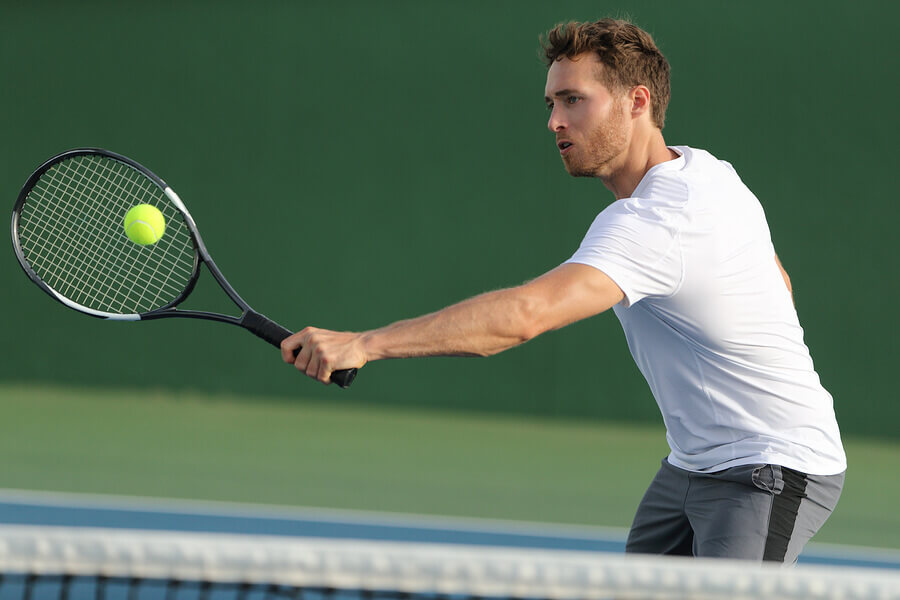Tennis Techniques: Improve your Backhand

Tennis players have to train every aspect of their game in order to improve their performance and results. That means they have to ensure better control with every hit. In addition, they need to move fast and get to where they need to be, alongside reading the game well. In today’s post, we want to focus on the first aspect; more specifically, we want to go over how to improve your backhand.
With a few months of practice, a beginner in tennis can learn how to hit a forehand. But backhand often requires more time to learn, regardless of the kind of grip.
Backhands can even be the weak-point of more advanced players as well. Every tennis player has a weakness and more often than not, it’s the side opposite to the hand they normally use.
Exercises for improving backhands
You can turn to various exercises to strengthen this weakness as well as following some of our tips. But the best remedy is to follow the guidance of a trainer or coach, who can quickly spot the areas you need to improve upon.
If you don’t have a coach, any tennis buddy can help you practice backhand. Or, if you’re going to practice by yourself, look for a wall to practice against.
1. Review your technique
If you want to improve your backhand, first check to see if you’re following through the right movements. First, you should use a continental or eastern grip. The side of the strings that’ll receive the ball should be slightly facing downwards.
Next, mind your stance. If you’re facing the net, you’ll hit the ball on a slant. Set your shoulders as a marker and always make sure your playing hand points to the net.

Move your feet according to the situation. For the most part, your feet should follow the same movements as your hits. But make sure you don’t cross your outward leg over too much as it could prevent you from keeping your balance after hitting the ball.
2. Repetition, a key for improvement
Though it seems basic and obvious, there’s nothing better than hitting balls that come at different speeds for mastering a technique. You can practice hitting balls with a friend (position yourselves diagonally from each other) or by yourself against a wall.
First, aim to hit the ball smoothly over the net. When you feel comfortable with your shots, move on to a more aggressive shot, which will allow your partner to practice slices. After, switch roles.
3. The backhand exercise
Many tennis players opt for a one-handed backhand. While it’s harder to master, it allows players to make a powerful shot. But how can you improve it?
Slow and steady wins the race. First, memorize the shot and its form. Your feet should stay in the same position but your racket shouldn’t start below your waist, as it would for a two-handed backhand. Instead, place it at the height of your head and your racket should be facing towards the side of the court. Meanwhile, keep your elbow down.
The movement for a one-handed backhand goes down first (towards the hips) and lifts up; just as with a forehand, finish upwards to seal the shot.
Practice it slowly at first without a ball. After, repeat the movement with a ball on a wall. When you get the hang of it, give it a try on the courts.
4. Adding speed to your backhand
You can give your backhand a stronger impact. When you add speed to your backhand, it’ll move on from being a mere defensive shot that continues the game, to a powerful weapon to outsmart your opponent.

It’s all about your backswing: the movement of rotating your waist inwards to push your shoulders outwards. This movement will generate distance between the racket and the point of contact, translating into a stronger impact.
We want to note that when you rotate your waist, your opposite hand should be close to your playing hand on the grip. If not, your elbow can hinder the movement.
So how can you practice this swing? Get a better view of what’s going on by standing in front of a mirror and moving through all of the steps. After, practice with a ball on a wall and finally, move on to the courts.
To wrap up our post, we’ve got an important tip for those without a coach: use your phone to film yourself making the swing and after, analyze your movements. It’s the best way to know if you’re doing everything correctly, as well as seeing if there’s anything you can improve on!
Tennis players have to train every aspect of their game in order to improve their performance and results. That means they have to ensure better control with every hit. In addition, they need to move fast and get to where they need to be, alongside reading the game well. In today’s post, we want to focus on the first aspect; more specifically, we want to go over how to improve your backhand.
With a few months of practice, a beginner in tennis can learn how to hit a forehand. But backhand often requires more time to learn, regardless of the kind of grip.
Backhands can even be the weak-point of more advanced players as well. Every tennis player has a weakness and more often than not, it’s the side opposite to the hand they normally use.
Exercises for improving backhands
You can turn to various exercises to strengthen this weakness as well as following some of our tips. But the best remedy is to follow the guidance of a trainer or coach, who can quickly spot the areas you need to improve upon.
If you don’t have a coach, any tennis buddy can help you practice backhand. Or, if you’re going to practice by yourself, look for a wall to practice against.
1. Review your technique
If you want to improve your backhand, first check to see if you’re following through the right movements. First, you should use a continental or eastern grip. The side of the strings that’ll receive the ball should be slightly facing downwards.
Next, mind your stance. If you’re facing the net, you’ll hit the ball on a slant. Set your shoulders as a marker and always make sure your playing hand points to the net.

Move your feet according to the situation. For the most part, your feet should follow the same movements as your hits. But make sure you don’t cross your outward leg over too much as it could prevent you from keeping your balance after hitting the ball.
2. Repetition, a key for improvement
Though it seems basic and obvious, there’s nothing better than hitting balls that come at different speeds for mastering a technique. You can practice hitting balls with a friend (position yourselves diagonally from each other) or by yourself against a wall.
First, aim to hit the ball smoothly over the net. When you feel comfortable with your shots, move on to a more aggressive shot, which will allow your partner to practice slices. After, switch roles.
3. The backhand exercise
Many tennis players opt for a one-handed backhand. While it’s harder to master, it allows players to make a powerful shot. But how can you improve it?
Slow and steady wins the race. First, memorize the shot and its form. Your feet should stay in the same position but your racket shouldn’t start below your waist, as it would for a two-handed backhand. Instead, place it at the height of your head and your racket should be facing towards the side of the court. Meanwhile, keep your elbow down.
The movement for a one-handed backhand goes down first (towards the hips) and lifts up; just as with a forehand, finish upwards to seal the shot.
Practice it slowly at first without a ball. After, repeat the movement with a ball on a wall. When you get the hang of it, give it a try on the courts.
4. Adding speed to your backhand
You can give your backhand a stronger impact. When you add speed to your backhand, it’ll move on from being a mere defensive shot that continues the game, to a powerful weapon to outsmart your opponent.

It’s all about your backswing: the movement of rotating your waist inwards to push your shoulders outwards. This movement will generate distance between the racket and the point of contact, translating into a stronger impact.
We want to note that when you rotate your waist, your opposite hand should be close to your playing hand on the grip. If not, your elbow can hinder the movement.
So how can you practice this swing? Get a better view of what’s going on by standing in front of a mirror and moving through all of the steps. After, practice with a ball on a wall and finally, move on to the courts.
To wrap up our post, we’ve got an important tip for those without a coach: use your phone to film yourself making the swing and after, analyze your movements. It’s the best way to know if you’re doing everything correctly, as well as seeing if there’s anything you can improve on!
All cited sources were thoroughly reviewed by our team to ensure their quality, reliability, currency, and validity. The bibliography of this article was considered reliable and of academic or scientific accuracy.
- Russell, Alejo. Desarrollo y técnica. Tácticas de tenis. Federación Dominicana de Tenis. http://www.fedotenis.org/media/16913/t%C3%A1cticas%20de%20tenis.pdf
- Russell, Alejo. Manual de tenis – Nivel 1 Instructor. https://torchpadeltenisadministracion.files.wordpress.com/2008/06/manual-de-tenis.pdf
This text is provided for informational purposes only and does not replace consultation with a professional. If in doubt, consult your specialist.








